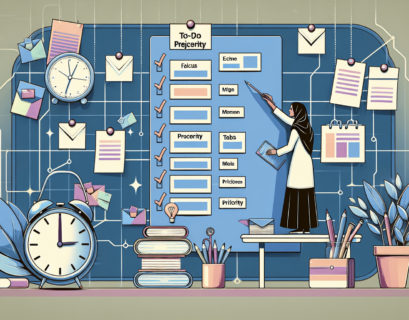Whether you’re a seasoned freelancer or just starting out, effective task management is crucial for success. The “Freelancer’s Guide To Time Blocking For Task Management” provides invaluable insights and strategies to make the most of your time and boost productivity. In this comprehensive guide, you’ll discover the benefits of time blocking, learn how to prioritize tasks, and explore practical techniques to stay focused and organized. Say goodbye to overwhelming workloads and hello to a more efficient and enjoyable freelancing experience.
Understanding the Concept of Time Blocking
Time blocking is a highly effective time management technique that involves dividing your day into specific blocks of time, each dedicated to a particular task or activity. Instead of having an open-ended to-do list, time blocking helps you structure your day, providing a clear plan and focus on how you will utilize your time. By allocating specific time slots for each task, you can better manage your workload and improve your overall productivity.
What is Time Blocking?
Time blocking is a method of organizing your schedule by breaking it up into fixed time intervals, usually ranging from 15 minutes to an hour or more. Each interval is assigned to a particular task, project, or activity, ensuring that you allocate the necessary time and attention to each one. By setting aside dedicated time blocks, you can eliminate distractions and fully immerse yourself in the task at hand.
Origins and Development of Time Blocking
The concept of time blocking can be traced back to the early 20th century when productivity experts started realizing the importance of managing time effectively. Over the years, various time management methodologies emerged, and time blocking gained popularity as a practical approach to boost productivity and efficiency.
Why is Time Blocking Important?
Time blocking is crucial for freelancers and professionals alike because it offers several key benefits. By implementing time blocking in your daily routine, you can experience increased focus and productivity, avoid burnout, achieve a better work-life balance, and successfully accomplish both short and long-term goals.
Benefits of Time Blocking for Freelancers
Increased Focus and Productivity
One of the primary advantages of time blocking for freelancers is the ability to enhance focus and productivity. By allocating specific time slots to each task, you eliminate the temptation to multitask and concentrate on one task at a time. This focused approach allows you to work more efficiently, complete tasks quicker, and maintain a high level of concentration throughout the day.
Avoidance of Burnout
Freelancers often face the challenge of managing their workload and avoiding burnout. Time blocking enables you to allocate sufficient time for both work and personal activities, ensuring you don’t overwork yourself. By scheduling breaks, leisure time, and self-care activities within your time blocks, you can maintain a healthy work-life balance and prevent burnout.
Improved Work-Life Balance
Creating dedicated blocks of time for personal activities is essential for maintaining a healthy work-life balance. With time blocking, you can allocate specific time slots for family, hobbies, exercise, and other non-work pursuits. By giving equal importance to both work and personal life, you can avoid the common pitfall of freelancers, which is dedicating all their time to work while neglecting their personal lives.
Achievement of Short and Long-term Goals
Time blocking helps freelancers set and achieve both short-term and long-term goals. By breaking down larger goals into smaller tasks and assigning specific time blocks for each task, you can make steady progress towards your objectives. This method allows you to visualize your progress, stay motivated, and ensures that you are consistently working towards your goals.
Tools Required for Time Blocking
Physical Planners and Schedules
Traditional physical planners and schedules are excellent tools for implementing time blocking. With a physical planner, you can visually organize your day, week, or month by allocating time blocks to various tasks. By having a tangible representation of your schedule, you can easily track your progress and make adjustments as necessary.
Digital Apps and Tools
Digital apps and tools offer a convenient and efficient way to implement time blocking. There are various productivity apps available, such as Trello, Todoist, Google Calendar, and Microsoft Outlook, that allow you to create digital schedules and allocate time blocks to different tasks. These apps often come with features like reminders, notifications, and syncing across devices, making it easy to stay organized and on track.
Time Tracking Software
Time tracking software can be a valuable asset when implementing time blocking. By using time tracking tools like Toggl, RescueTime, or Harvest, you can accurately monitor the time spent on each task. This data can help you analyze your productivity, identify time-consuming activities, and make informed decisions to optimize your time blocking schedule.
Steps To Implement Time Blocking
Listing of Tasks and Responsibilities
To effectively implement time blocking, start by creating a comprehensive list of all your tasks and responsibilities. This includes both work-related tasks and personal activities. By having a clear overview of everything you need to accomplish, you can better organize your time blocks and prioritize tasks accordingly.
Estimate the Time Required For Each Task
Once you have your task list, estimate the time required for each task. Be realistic but try to challenge yourself by setting reasonable deadlines. This estimation will help you determine the appropriate length for each time block and allow you to allocate enough time to complete each task.
Assigning Specific Time Slots For Each Task
With your tasks and time estimates in hand, assign specific time slots for each task. Consider your energy levels throughout the day and assign complex or mentally demanding tasks during high-energy periods. Break down larger tasks into smaller subtasks if necessary, and allocate dedicated time blocks for them.
Protecting Time Blocks
It’s crucial to protect your allocated time blocks from distractions and interruptions. Communicate your availability to clients, colleagues, and family members, and ensure they understand and respect your scheduled time blocks. Turn off notifications on your phone or computer during focused work sessions to minimize distractions and stay on track.
Ensuring Balance and Flexibility
While time blocking provides structure and organization to your day, it’s essential to maintain a balance between your tasks. Avoid overloading your schedule or cramming too many tasks into a single time block. Leave room for breaks, relaxation, and unforeseen circumstances. Flexibility is key to adapting and accommodating changes that may arise throughout the day.
How to Set Priorities within Time Blocking
Understanding Priority Levels
Setting priorities is crucial within the time blocking framework. Start by categorizing your tasks into different priority levels. For example, you can categorize tasks as high, medium, or low priority based on urgency and importance. This classification will help you allocate your time blocks accordingly and ensure that you focus on the most critical tasks first.
Balancing Urgent vs. Important Tasks
Time blocking allows you to strike a balance between urgent and important tasks. While some tasks may be time-sensitive and require immediate attention, it’s important not to neglect tasks that may have long-term benefits or contribute to your overall goals. By allocating specific time blocks for important tasks, you can ensure their completion while still addressing urgent matters.
Setting Daily and Weekly Priorities
In addition to the broader prioritization of tasks, it’s advisable to set daily and weekly priorities within each time block. At the beginning of each day, identify the most crucial tasks you want to accomplish and allocate specific time blocks for them. Regularly reviewing and adjusting your priorities ensures that you stay focused and continue making progress towards your goals.
Techniques to Optimize Time Blocking
The Pomodoro Technique
The Pomodoro Technique is a popular time management method that complements time blocking. It involves breaking your work into intervals, traditionally 25 minutes long, called “Pomodoros.” After each Pomodoro, take a short break before starting the next one. This technique helps maintain focus and productivity by incorporating regular breaks, preventing burnout, and improving overall efficiency.
Eisenhower Box
The Eisenhower Box is another effective technique to optimize time blocking. It involves categorizing tasks into four quadrants based on urgency and importance: “Urgent and Important,” “Important but not Urgent,” “Urgent but not Important,” and “Not Urgent or Important.” By using this method, you can prioritize tasks within your time blocks and allocate dedicated time to important tasks that may not be urgent yet.
Batching: Grouping Similar Tasks Together
Batching is a technique where you group similar tasks together within a specific time block. By working on similar tasks consecutively, you can minimize context switching and maximize productivity. For example, instead of responding to emails throughout the day, allocate a specific time block for email management. Batching tasks allows you to streamline your workflow and complete related tasks efficiently.
Buffer Blocks: Allocating Time for Unexpected Tasks
Buffer blocks are essential for accommodating unexpected tasks or interruptions. Allocate dedicated time blocks that serve as buffer periods to handle unscheduled or urgent activities that may arise. By including buffer blocks in your time blocking schedule, you can ensure that unexpected tasks don’t derail your entire day and have a realistic plan to address them without stressing or compromising on other tasks.
Common Challenges in Time Blocking and their Solutions
Preventing Procrastination
Procrastination can be a significant challenge when implementing time blocking. To overcome this, break down tasks into smaller, manageable subtasks. By tackling smaller segments of a task, it becomes less overwhelming and easier to start. Additionally, make use of time tracking software to measure your progress and hold yourself accountable for completing tasks within the allocated time blocks.
Managing Distractions
Distractions, such as social media, emails, or interruptions, can severely impact productivity during time blocks. Minimize distractions by turning off notifications or using website blockers during focused work periods. Communicate your availability to family, friends, or colleagues, so they understand when you are not to be disturbed. Find a quiet and dedicated workspace to limit external distractions and optimize your focus.
Handling Overlapping Tasks
Overlapping tasks can occur if you underestimate the time required for a task or if unforeseen circumstances arise. When faced with overlapping tasks, assess their urgency and importance. Determine if any tasks can be delegated or if some can be completed at a later time without major consequences. Be flexible and open to adjusting the time blocks or shifting tasks around to accommodate unexpected situations.
Creating Blocks for Personal Time
Allocating Time for Breaks
Breaks are essential for maintaining focus, preventing burnout, and promoting overall well-being. Allocate specific time blocks for breaks throughout your day, and make sure to take them. Use these breaks to stretch, go for a short walk, or engage in activities that help you relax and recharge. By incorporating regular breaks, you can maintain productivity and avoid feeling overwhelmed or mentally drained.
Making Time for Self-care Activities
Self-care activities play a vital role in maintaining a healthy work-life balance. Allocate dedicated time blocks for self-care, such as meditation, reading, practicing mindfulness, or engaging in hobbies or interests that bring you joy. Prioritizing self-care ensures that you recharge your energy, reduce stress, and nurture your overall well-being, enabling you to perform at your best when working.
Incorporating Exercises and Hobbies into Time Blocking
Physical exercise and hobbies often take a backseat for freelancers due to their demanding work schedules. However, it’s important to allocate time blocks for exercise and hobbies to prioritize your physical and mental health. Whether it’s scheduling a workout session, carving out time for a hobby, or participating in a recreational activity, incorporating these activities into your time blocking schedule helps you maintain a balanced and fulfilling lifestyle.
Long-term Implementation of Time Blocking
Learning from Mistakes
Time blocking requires practice, adjustment, and learning from mistakes. It’s essential to evaluate your time blocking schedule regularly and identify aspects that need improvement or modification. Reflect on previous time blocks, identify areas where you may have fallen behind or overestimated your capabilities, and make necessary adjustments to avoid repeating similar mistakes in the future.
Adapting and Modifying the Time Blocking Schedule
Flexibility is key to successful long-term implementation of time blocking. As your workload, priorities, and personal circumstances may change over time, it’s crucial to adapt and modify your time blocking schedule accordingly. Be open to experimentation, analyze the effectiveness of different time blocks, and make adjustments to ensure your time blocking approach aligns with your evolving needs and goals.
Discovering Personal Most Productive Times
Each individual has their own peak productivity periods during the day. Pay attention to your energy levels and identify when you are most productive and focused. This is the time to allocate for more complex or mentally demanding tasks within your time blocking schedule. Discovering your personal most productive times allows you to optimize your schedule and make the most of your high-energy periods.
Case Studies of Successful Time Blocking in Freelancing
Freelancer Case Study 1
One freelance writer, Sarah, implemented time blocking in her workflow and experienced tremendous benefits. By allocating specific time blocks for research, writing, editing, and client communication, Sarah found that she could complete projects more efficiently and deliver high-quality work. She also incorporated breaks, exercise, and personal time into her schedule, resulting in improved work-life balance and reduced stress.
Freelancer Case Study 2
John, a freelance graphic designer, adopted time blocking to better manage his projects and deadlines. By assigning specific time blocks for each project, including brainstorming, designing, and revisions, John was able to complete his projects within the deadlines and deliver exceptional design work. With time blocking, he was also able to dedicate time for skill development and exploring new design trends, leading to continuous professional growth.
Learning Points from Case Studies
From these case studies, we can learn that implementing time blocking can have a significant positive impact on freelancers. By organizing tasks, setting priorities, and allocating specific time blocks, freelancers can increase productivity, avoid burnout, achieve a better work-life balance, and successfully accomplish personal and professional goals. Time blocking offers structure, focus, and flexibility, facilitating efficient task management and overall career growth for freelancers.
In conclusion, time blocking is a valuable technique that allows freelancers to manage their tasks effectively, increase productivity, and achieve a better work-life balance. By understanding the concept of time blocking, utilizing the right tools, and implementing the recommended techniques, freelancers can optimize their workflow, prioritize tasks, and achieve their goals successfully. With the benefits of time blocking, freelancers can thrive in their careers while maintaining personal well-being and enjoying a fulfilling lifestyle.







